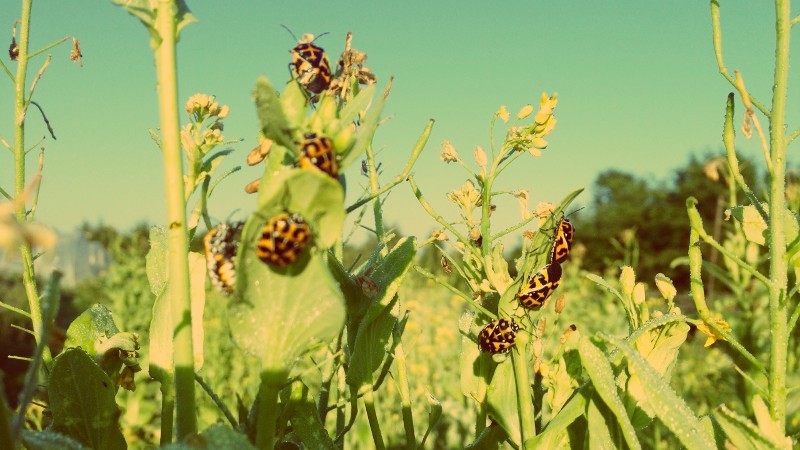How To Manage Pests & Diseases On Your Farm?

As a farmer, one of the biggest challenges you may face is managing pests and diseases on your farm. With the changing climate and growing global food demand, it is increasingly important to find sustainable and effective ways to protect crops and livestock from harmful invaders. Whether you grow crops or raise livestock, it’s crucial to have a solid plan in place to deal with pests and diseases.
To manage pests and diseases on your farm, use integrated pest management, biological controls, proper sanitation, crop rotation, and prompt treatment of pests and diseases. Monitor crops and livestock regularly. Implement preventative measures to reduce pest populations and maintain healthy crops and livestock.
This article will discuss practical tips and strategies for effectively managing pests and diseases on your farm. We’ll cover the importance of regular monitoring, the benefits of integrated pest management, and the use of biological controls. We’ll also provide tips for identifying and treating common pests and diseases. By following these guidelines, you can ensure that your farm is protected and that your crops and livestock remain healthy and productive.
How can pests and diseases on your farm be controlled?
Managing pests and diseases on your farm is essential to maintaining healthy crops and livestock. Here are some detailed steps to help you manage pests and diseases on your farm:
- Regular Monitoring
- Integrated Pest Management (IPM)
- Biological Controls
- Sanitation
- Crop Rotation
- Proper Treatment
By following these steps, you can effectively manage pests and diseases on your farm, maintain healthy crops and livestock, and reduce the need for harmful pesticides.
Regular Monitoring
Regular monitoring is essential in managing pests and diseases on your farm. This involves regularly inspecting crops and livestock for signs of infestation, such as unusual discoloration, wilting, or a decline in production. Early detection of pests and diseases is crucial for effective management and can help prevent the spread of infestations.
To effectively monitor your farm, it’s important to establish a routine and stick to it. Schedule regular inspections at least once a week and more frequently during the growing season. During inspections, thoroughly examine crops and livestock for any signs of infestation. Take note of any unusual symptoms and keep a record of the issue’s date, location, and severity.
In addition to regular inspections, consider using tools such as traps and sticky tape to monitor pest populations. You can also monitor the growth and development of crops to detect early signs of pest damage.
Integrated Pest Management (IPM)
Integrated Pest Management (IPM) is a sustainable approach to managing pests and diseases on your farm. It combines different control methods, such as cultural, physical, and chemical controls, to minimize the use of harmful pesticides. IPM aims to reduce pest populations to levels that do not cause significant economic damage to crops and livestock.
To implement IPM on your farm, it’s important to start with cultural controls, such as crop rotation and sanitation, to reduce pest populations. Physical controls, such as barriers and screens, can also prevent pests from reaching crops and livestock. Chemical controls should only be used as a last resort and in conjunction with other IPM techniques. When chemical controls are necessary, choose less toxic products and target specific pests rather than broad-spectrum chemicals.
IPM is a proactive and flexible approach that requires regular monitoring and the ability to adjust control methods as needed. By implementing IPM on your farm, you can effectively manage pests and diseases while reducing the use of harmful pesticides and maintaining a healthy and sustainable farm environment.
Biological Controls
Biological controls are a key component of Integrated Pest Management (IPM) and involve using natural predators to control pests. By encouraging the growth of beneficial insects, such as ladybugs and lacewings, you can help control pests and reduce the need for chemical inputs.
To implement biological controls on your farm, it’s important to create a habitat that attracts and supports beneficial insects. This can be done by planting flowers and herbs that provide food and shelter, such as dill, fennel, and yarrow. Additionally, preserving natural habitats, such as hedgerows and wetlands, can help provide refuge for beneficial insects and other natural predators.
Using biological controls is a sustainable and effective way to manage pests and diseases on your farm. By encouraging the growth of beneficial insects, you can help control pests, reduce the need for harmful pesticides, and maintain a healthy and balanced ecosystem on your farm.
Regular monitoring and integrated pest management techniques, such as crop rotation and sanitation, can also help support biological controls and provide a comprehensive approach to pest and disease management.
Sanitation
Sanitation is an important step in managing pests and diseases on your farm. Maintaining cleanliness on the farm can help reduce pest populations and prevent the spread of diseases. This includes removing dead plant material, rotating crops, and properly disposing infected crops or livestock.
To effectively maintain sanitation on your farm, it’s important to establish a routine and stick to it. This includes regularly removing dead plant material and weeds, as well as rotating crops to reduce the soil’s buildup of pests and diseases. It’s also important to properly dispose of infected crops or livestock to prevent the spread of disease.
In addition to regular sanitation practices, consider using barriers and screens to prevent pests from reaching crops and livestock. Proper storage and disposal of food waste can also help reduce pest populations.
Crop Rotation
Crop rotation is crucial in managing your farm’s pests and diseases. By rotating crops, you can reduce the buildup of pests and diseases in the soil and improve soil health. This is achieved by planting different crops in a specific order each year so that different crops are grown in a specific field in consecutive seasons.
To effectively implement crop rotation on your farm, it’s important to create a plan that considers each crop’s specific needs. For example, crops that belong to the same family should not be grown in the same location in consecutive years, as they can attract similar pests and diseases. Additionally, rotating crops with deep root systems with crops with shallow root systems can help improve soil structure and reduce the buildup of pests and diseases.
Crop rotation is a simple and effective way to manage pests and diseases on your farm. By rotating crops, you can reduce the buildup of pests and diseases in the soil, improve soil health, and maintain a healthy and sustainable farm environment.
Proper Treatment
Proper treatment is essential in managing pests and diseases on your farm. When pests and diseases are identified, it’s important to take prompt and appropriate action to prevent further spread and damage. This may include using chemical or biological controls, such as pesticides or natural predators, as well as other management techniques, such as crop rotation and sanitation.
To effectively treat pests and diseases on your farm, it’s important to follow label instructions when using chemical controls, such as pesticides. When choosing a pesticide, consider the specific pest or disease being treated and select a product specifically designed for that target. Additionally, always use personal protective equipment and follow proper application techniques to minimize exposure to harmful chemicals.
Proper treatment is a critical step in managing pests and diseases on your farm. Taking prompt and appropriate action can prevent further spread and damage and maintain a healthy and sustainable farm environment.
Additionally, combining proper treatment with other pest management techniques, such as regular monitoring and integrated pest management (IPM), can provide a comprehensive approach to pest and disease management.
Importance of pest and disease management
Effective pest and disease management is essential for the success and sustainability of any farm. By controlling pests and diseases, farmers can improve crop yields, reduce the need for harmful chemicals, and maintain a healthy and balanced ecosystem on the farm. This, in turn, leads to better economic outcomes and a higher quality of life for the farmer and their community.
Pest and disease management is also important for food safety and security. By controlling pests and diseases, farmers can reduce the risk of contamination and ensure that their crops and livestock are safe for consumption. This is particularly important in countries where food is scarce, and access to quality food is limited.
In addition to improving yields and food safety, effective pest and disease management also has environmental benefits. By reducing the need for harmful chemicals, farmers can minimize their environmental impact and help conserve natural resources, such as water and soil.
By using integrated pest management (IPM) techniques, such as crop rotation and biological controls, farmers can maintain a healthy and sustainable farm environment for future generations.

